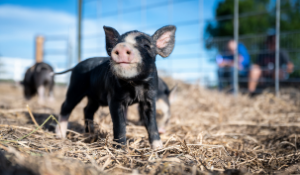- Posted by Anitox
Feed Essential to Biosecurity Plans as ASF Is Confirmed in Germany
Whenever there’s a new incidence of a notifiable disease, the local authorities swing into action, implementing crisis management plans to contain the spread of the infection. As news disseminates, there’s inevitability renewed interest from a broader audience into the questions ‘how did this happen?’ and ‘how can we stop this happening again?’
Germany is now sadly in the midst of such an incident. On 10th September 2020, German agriculture minister Julia Klockner confirmed the country’s first case of African Swine Fever (ASF) when preliminary tests on a wild boar, found on near the border with Poland, returned positive.
While ASF does not affect humans, it can be devastating for farmers and the wider meat industry. It has a fatality rate of up to 100%, according to the FAO1 and, culling infected animals is our only effective control measure2.
In China, over one million of the country’s pigs have been slaughtered3 and it is forecast to reduce China’s pork production by 35-40%4.
There are ramifications downstream too. With the potential for imports bans and a loss of consumer confidence, the whole food chain feels the effects of such an incident.
As the German Federal Government and its associated agencies are focused on shielding domesticated swine from infection, German farmers will be taking action to protect their herds by reviewing and implementing their biosecurity plans.
One essential element of those biosecurity plans is feed.
Feed’s potential to transmit African Swine Fever (ASF)
Feed may not be the primary vector for ASF but there is compelling evidence that it is a fomite.
In 2018 a detailed study evaluated virus survival in both complete feed and common raw ingredients, such as soybean meal, essential amino acids and vitamins. They found viruses including ASF surviving in both. (Dee et al, 20185)
Unlike other sources of contamination, feed has the potential to transmit viruses to multiple outlets. Infection from wild animals to farmed animals, whether through direct contact, bodily fluids or faeces, is more likely to cause localised outbreaks. Transmission of ASF via vehicles, equipment or people will infect only those herds that come into contact with the vector.
Feed, on the other hand, is often distributed to multiple farms and has the potential to contaminate whole herds across a broad geographic area.
How can feed be contaminated by African Swine Fever (ASF)?
Feed is most likely contaminated when raw materials are being grown in the field. Images of wild boar feeding in maize, soya and cereal fields (and leaving faeces, urine and partially eaten husks etc) are widespread on the internet. The boar may only leave the field as and when the combine harvests it. The combine cannot discriminate between untouched feed and partly eaten, soiled or contaminated feed, and so within minutes of the infected boars presence these raw materials may be included in the raw material chain. During the milling process the virus can be mixed and spread throughout the finished feed.
Protecting feed from contamination
With African Swine Fever contamination possible throughout the lifecycle of feed, longer-term control is required. Products, such as Termin-8R and FinioR, offer residual action, protecting feed from viruses during processing, packing and transport.
Formaldehyde, a key ingredient in Termin-8 R, has been shown to be highly effective in killing viruses, including African Swine Fever6.
Both Termin-8 and Finio safeguard feed from other pathogens too and have been proven to lower feed conversion rates and improve daily live weight gain.
Message to the European meat industry
Our thoughts go out to all those in Germany and Europe who have been affected and are under threat from, African Swine Fever. Our local feed safety experts are here for you, on-hand for anyone - integrated producers, feed mills, farmers or regulators - wanting to discuss or review the biosecurity of feed.
Sources:
2 EFSA, https://ec.europa.eu/food/animals/animal-diseases/control-measures/asf_en
4 Rabobank, 2019 https://research.rabobank.com/far/en/sectors/animal-protein/African_Swine_Fever_A_Global_Update_December2019.html
5 Dee et al 2018
6 EFSA 2009, summarised Haas et al 1995


